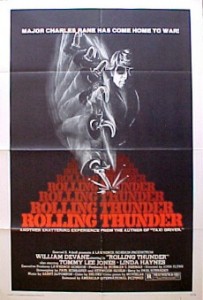 “Rolling Thunder” is a brilliant, underrated masterpiece that centers solely on the loneliness and brutality inside the character of Maj. Charles Rane. The film is in the same painful vein as “Taxi Driver,” which is why it would come as no surprise that Paul Schrader penned both screenplays. This picture is an honest look at the damage to the psyche that many men faced after Vietnam, which turned some of them into ticking time bombs. The difference between Rane’s story and all the others is that he is pushed to the point of no return, where he has no choice but to explode.
“Rolling Thunder” is a brilliant, underrated masterpiece that centers solely on the loneliness and brutality inside the character of Maj. Charles Rane. The film is in the same painful vein as “Taxi Driver,” which is why it would come as no surprise that Paul Schrader penned both screenplays. This picture is an honest look at the damage to the psyche that many men faced after Vietnam, which turned some of them into ticking time bombs. The difference between Rane’s story and all the others is that he is pushed to the point of no return, where he has no choice but to explode.
Rane (William Devane) and several colleagues return home to Texas after spending seven years in Hanoi as a prisoner of war. He has endured years of torture and abuse that has left him emotionally and physically numb. A hero’s welcome is deservedly given to him, and the town rewards him with a Cadillac and a large amount of silver dollars.
However, Rane’s nightmare is just beginning, and he shortly discovers that his wife has been cheating on him while he was in Hanoi. His life is crumbling, but what keeps him going is the love and chance to bond with his son, whom he had not seen since he was a baby.
His reality is completely shattered when a few guys decide they want to steal his silver dollars. They break into his house and attempt to torture the hardened Rane to find out where the coins are hidden. He refuses to talk despite the torture, which includes putting his hand into a garbage disposal. His son, in an attempt to help, tells the men where the coins are, only to be brutally shot in cold blood. Rane is left for dead and wakes up several days later in the hospital with revenge on his mind.
Devane is exceptional as Rane, who we can easily sympathize with. His demeanor is calm, cool and confident, and you can see the pain he feels in his eyes. This character has been through hell, and hardly anyone in the movie can understand exactly what that means.
The only one that seems to completely understand the man is Johnny Vohden, who was a prisoner in the POW camp with him. The audience is treated to an excellent and early performance from Tommy Lee Jones. Several early sequences showcase the talent of the two leads, who discuss with minimal words the horrors of Vietnam. This is the type of acting that should be studied in classrooms for anyone interested in becoming an actor someday.
The unspoken bond between Rane and Vohden extends throughout the picture, and when Rane finds the men that killed his son and tells Vohden, all he says is “I’ll get my stuff.”
That small scene is what sets the audience up for one of the most violent and exceptionally well-done endings to a picture. This is a film that leaves you on the edge of your seat.
The film is not light in tone except for a few scenes between Rane and a young girl that admires him, who is played by “Human Experiments” star Linda Haynes. This character is everything his wife should have been, and gives him the opportunity to understand that the world is not all that bad. The grim picture needed this glimmer of hope, and Haynes becomes a driving force of light.
But anyone who has ever seen a film written by Schrader knows that hope slowly diminishes for all of his main characters as they descend into madness and horror. He is probably known for his collaborations with Scorsese, which include “Taxi Driver,” “The Last Temptation of Christ” and the exceptional “Bringing Out the Dead.” The common thread in these screenplays is often a damaged human being trying to overcome extreme difficulties to fix the problems of the society they inhibit, and that is ever present in “Rolling Thunder.”
“Rolling Thunder” is a picture that seemed to fall through the cracks of cinema to be considered by many as an exploitation picture, which it is not. The film’s statement is made apparent early on, and after that, all you can do is wait for Rane and Vohden to reclaim their justice.

Leave a Reply